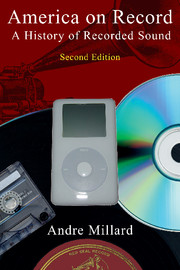Book contents
- Frontmatter
- Dedication
- Contents
- Preface to the second edition
- Preface to the first edition
- Introduction
- Part One The acoustic era
- Part Two The electrical era
- 6 The machines
- 7 Competing technologies
- 8 Empires of sound
- 9 Swing and the mass audience
- 10 High fidelity at last
- 11 Rock'n'roll and the revolution in music
- 12 The record
- 13 The studio
- 14 Perfecting studio recording
- 15 The cassette culture
- Part Three The digital era
- Abbreviations used in the notes
- Notes
- Select discography
- Select bibliography
- Subject index
- Recordings index
- Motion picture index
13 - The studio
from Part Two - The electrical era
Published online by Cambridge University Press: 05 February 2015
- Frontmatter
- Dedication
- Contents
- Preface to the second edition
- Preface to the first edition
- Introduction
- Part One The acoustic era
- Part Two The electrical era
- 6 The machines
- 7 Competing technologies
- 8 Empires of sound
- 9 Swing and the mass audience
- 10 High fidelity at last
- 11 Rock'n'roll and the revolution in music
- 12 The record
- 13 The studio
- 14 Perfecting studio recording
- 15 The cassette culture
- Part Three The digital era
- Abbreviations used in the notes
- Notes
- Select discography
- Select bibliography
- Subject index
- Recordings index
- Motion picture index
Summary
The place where records are made is usually called a studio, but in Edison's day it was often called a laboratory. The Big Three companies used this term to give their customers the impression that sound recording was constantly being improved, which it was. The first recording studio was established in Thomas Edison's West Orange laboratory in 1888. It was on the top floor of the main laboratory building, a large open space under a vaulted ceiling. During the frantic campaign to perfect the phonograph in 1888, Edison's men hauled a piano up there and used it for experiments on recording. At first this work was carried out in the open space of the room, but soon the recording phonograph was enclosed behind a wooden partition, with only the horn showing through it at head height. The musicians crowded around the horn, while the experimenters and their machinery remained out of sight behind the acoustic barrier – an important physical distinction had been made between artist and technician. Absolute silence was maintained while the recording was made. The first steps towards the recording studio had been taken.
Another common term used to describe a studio was recording room; usually this is exactly what it was, a room in the factory or offices of a record company. The first gramophone recording studio was over a shoe shop on 12th Street in Philadelphia. When Fred Gaisberg went to England, he set up the studio for the Gramophone Company in the basement room of its offices in London. The recording room for the United States Phonograph Company in 1892 was a loft over a meat packing house.
Even these humble spaces were a great improvement over the hotel rooms, penny arcades, and parlors that had acted as recording facilities for the first group of entrepreneurs engaged in producing commercial records. In the early 1890s, penny arcade operators and travelling phonograph exhibitors needed pre-recorded cylinders and discs, and they made records by the dozen wherever they could.
- Type
- Chapter
- Information
- America on RecordA History of Recorded Sound, pp. 258 - 284Publisher: Cambridge University PressPrint publication year: 2005



